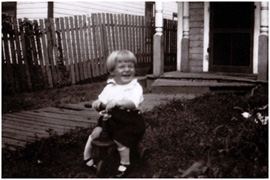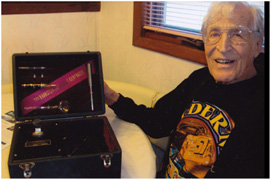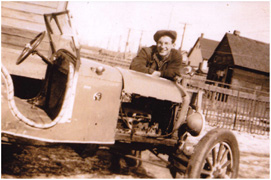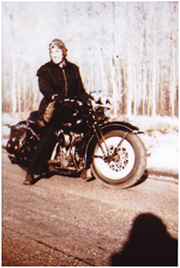“Submitted by Sandra Rutherford Chairperson, Thunder Bay and District Post-Polio Chapter”
TREASURES IN OUR MIDST! Representing the Thunder Bay & District Post-Polio Chapter allows me opportunities to glean Polio nuggets from our precious men and women, who survived the crippler’s assault, and bravely stayed the course of grueling rehabilitation. Many recovered to lead productive lives with little or no aftereffects. For most, however, it would be a host of daunting adaptations to reclaim and enjoy each milestone that life presents from our first breath to our last. Here in the Northwest, we have a hearty group whose journeys glisten with camaraderie, ingenuity, wit and grit.

William (Bill) Montgomery is one of our well-seasoned testaments. At 91 years (and counting) he’s withstood many a road block that threatened to trip him up from the get go. He was two years old (in 1922) when Polio paralyzed his right leg, and weakened the family’s stability as well. Seven years had passed since the end of the First World War; the economic forecast although promising was wobbly at best. To make a half-decent living was not for the faint of heart. Food on the table cost the sweat of your brow, and when a family was struck with a disease like Polio you needed more than sweat to get by. For starters, the very mention of ‘Polio’ seethed panic in the community. A sign was posted in the yard quarantining the family or as some would tell you it was like society had cast you aside as was done to lepers in Bible times. People were afraid to go anywhere near you even after the doc gave the all clear. So you felt ostracized and terrified as these frantic parents were for Bill, who the day before was full of life. In my mind’s eye I can see him walking, and as siblings do, annoying his older sister, June, and I think how often we wish things to be as they were.
Fortunately for the Montgomery family, they had an ace in the hole. Bill’s maternal grandmother, Hannah Jane Newbury, was a Registered Nurse in the employ of the family’s G.P., a Dr. Cook in Fort William (now Thunder Bay). Ga, (as Bill affectionately called her), took charge straight away, and for the next several years Bill’s day included a tub bath in warm water, gentle exercising of his legs, and a treatment with an electrical machine from the doctor’s office that screwed into a light socket. Ga massaged Bill’s Polio-affected leg with a device Bill says resembled a small coke bottle. Its purpose was to stimulate blood flow to the nerves in an attempt to develop atrophied muscles.

This machine according to the critics was not sound medical treatment and thus considered ‘quackery’ but without it, Bill is quick to tell you he would not have been able to walk again or to be rid of the metal brace he had to wear to keep his leg straight until he was eight. This is Bill at 90, in 2011, pictured with the Branston Violet Ray High Efficiency Generator, which enabled him to walk again, albeit with a limp. But a limp would not dissuade him from trying out for the baseball team at Drew Street School. His efforts were met with the coach yelling at him to “get out of there” – he showed no compassion or recognition that this eleven year-old was as keen as his fellow classmates were for a role on the team. Bill had no desire after that for sports at school. “I never had a teacher,” he told me, “who said anything kind”. Their insults and lack of empathy cut him far deeper than the kids who called him "gimp".
Teachers worth their salt empower students for success. Sadly, none were in Bill’s corner. They’d so set his teeth on edge that he quit in his second year of high school. He knew he had it in him to do most anything when he set his mind to it. He was as keen to learn and destined for success as any young lad, given the chance.

At sixteen he paid $4.00 for parts from a 1919 Ford Model T. Putting his inventive skills to work and shaping the car’s exterior with sheet metal, he created his very own “tin lizzie” (as was the jargon of the day for a Model T). Bill so impressed the neigbours that it was he whom they talked about over Sunday dinner, (giving the church parson a reprieve as the usual spin was what you liked or didn’t like about his sermon). From house to house it was the same: "Did you hear? Did you see the car that young Bill Montgomery made outta scrap? And he drove it clear round town and on out to the race track in Murillo, egged on by his buddies to see how fast it would go. I hear they could barely see Bill or his car for dust. What a guy!"
During the Second World War Bill was hired by Canada Car in Fort William and then in Oshawa where he learned pilot training, sufficient for test-driving the planes he worked on. This ability would land him a job at the plant in Montreal if he wanted it. But lonesome for home, it was home he went, much to the delight of his mom and his nieces and nephews who idolized their Uncle Bill.
He soon found a job with Kam Power. Digging holes for hydro poles the rest of his life was not to his liking. So at twenty-five (in 1945) his boss, Ernie Elvish, encouraged him to give schooling another try. Although physically bushed after a long day at work, Bill hit the books each night. He passed a correspondence course in electricity. In 1947 Kam Power was sold to Fort William Hydro and Bill was hired on as a Systems Operator.

Having a secure job and earning a decent wage, Bill itched for speed and travel. He bought a spanking brand new 1947 Harley Davidson. Many a weekend he and his buddies revved up their Harleys for rippin’ down (what is now) Highway 61 and across the Pigeon River Border for a cold one at their favourite watering hole.
Bill and a buddy also sped to New Orleans. They slept in motel rooms, their Harleys in the room with them so they wouldn’t get nicked during the night.
In his thirties Bill took to the slopes and mastered downhill skiing, and then (to stay in shape) water skiing on Lake Agimak, at his camp in Ignace. In his fifties he passed a grueling Deep Sea Navy Diver’s Course, just for the thrill of experiencing the plethora of life in Florida’s Key West, and in Australia’s Great Barrier Reef.
Bill has captured thousands of moments to memory and on film of his travels, which include Jamaica, New Zealand, Spain, Portugal, Morocco, Kenya, Russia, Finland, China, the Amazon, plus a number of cruises around the world. He’d still be out there somewhere kicking up his heels, had he not been stricken with Guillain-Barré Syndrome when he was 78 (in 1998) and then a Stroke in his eighties. Remarkably, he regained his ability to drive and was content to enjoy life at home with his dog, Dewey.
At eighty-nine Bill got a hankerin’ to give the old fiddle a try. Many a morning was spent, first exercising his limbs to keep his strength up, and then soothing his yen for tunes of yesteryear like ‘Daisy, Daisy, Give Me Your Answer Do’ and ‘Take Me Out To The Ball Game’. Bill says his music teacher was so impressed by his oldest student’s commitment to practice, that he hopes his younger protégés will follow Bill’s example.
In April (2011), mere days after celebrating his ninety-first, Bill fell and fractured his polio hip. Surgery, pneumonia, and an infection that is too common these day in hospitals, have not deterred his zest for independence. I visit with him regularly and I can tell you that barring another setback, Bill will be back to living how he wants to and where he is most comfortable. He is not content to work hard only during scheduled physio sessions. He asked me to bunch up a blanket at the bottom of the bed so he could press his feet into it, take a little rest, and then start again.
As far as I know Bill is the lone person today, living with Polio since he was two. (That’s 89 years and counting!). He is indeed a Treasure in our Midst.
Bill’s resounding ‘yes’ (and agreed by many in our chapter) to ‘seize the day’ because our stories are compelling and vital for our young people to understand why Polio is more than a disease of the 1900s. – It is a real and present threat in 2011. – Polio awareness can go a long way in curbing complacency, until no one anywhere on the planet is at risk.
